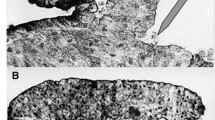Abstract
We present a methodology for the modelling of spatially-aware biological phenomena, based on the description of the movement of membranes in the Euclidean space. The time evolution of the system is described by an iterative algorithm, which determines the movement of the objects according to the actions they perform, and the constraints they are subjected to. We exemplify our approach with a model of the morphogenesis of Dictyostelium discoideum, and present the results of its simulation.















Similar content being viewed by others
Notes
Term \(\| p_j[t]-p_i[t] \|\) corresponds to the Euclidean distance between \( p_{j}{[t]}\) and \( p_{i}{[t]}\).
References
Barbuti R, Maggiolo-Schettini A, Milazzo P, Troina A (2006) A calculus of looping sequences for modelling microbiological systems. Fundam Inf 72(1–3):21–35
Barbuti R, Maggiolo-Schettini A, Milazzo P, Tiberi P, Troina A (2008) Stochastic calculus of looping sequences for the modelling and simulation of cellular pathways. In: Priami C (ed) Transactions on computational systems biology IX. Lecture Notes in Computer Science, vol 9. Springer, Berlin, pp 86–113
Barbuti R, Maggiolo-Schettini A, Milazzo P, Pardini G (2011) Spatial calculus of looping sequences. Theor Comput Sci 412(43):5976–6001
Barbuti R, Maggiolo-Schettini A, Milazzo P, Pardini G, Tesei L (2011) Spatial P systems. Nat Comput 10(1):3–16
Barbuti R, Maggiolo-Schettini A, Milazzo P, Pardini G (2013) Simulation of spatial P system models. Theor Comput Sci. doi:10.1016/j.tcs.2013.08.002
Cardelli L (2005) Brane Calculi– interactions of biological membranes. In: Danos V, Schachter V (eds) Computational methods in systems biology. Lecture Notes in Computer Science, vol 3082. Springer, Berlin, pp 257–278
Cardelli L, Gardner P (2010) Processes in space. In: Ferreira F, Löwe B, Mayordomo E, Mendes Gomes L (eds) Programs, proofs, processes. Lecture Notes in Computer Science, vol 6158. Springer, Berlin, pp 78–87
Davidson LA, Koehl MAR, Keller R, Oster GF (1995) How do sea urchins invaginate? Using biomechanics to distinguish between mechanisms of primary invagination. Development 121(7):2005–2018
Drasdo D, Forgacs G (2000) Modeling the interplay of generic and genetic mechanisms in cleavage, blastulation, and gastrulation. Dev Dyn 219(2):182–191
Graner F, Glazier JA (1992) Simulation of biological cell sorting using a two-dimensional extended potts model. Phys Rev Lett 69:2013–2016
Hardin JD, Cheng LY (1986) The mechanisms and mechanics of archenteron elongation during sea urchin gastrulation. Dev Biol 115:490–501
John M, Ewald R, Uhrmacher AM (2008) A spatial extension to the π-calculus. Electronic notes in theoretical computer science 194(3):133–148. Proceedings of the first workshop from biology to concurrency and back (FBTC 2007)
Kominami T, Takata H (2004) Gastrulation in the sea urchin embryo: a model system for analyzing the morphogenesis of a monolayered epithelium. Dev Growth Differ 46(4):309–326
Manca V (2013) Infobiotics: information in biotic systems. Springer, Berlin
Maree AF, Hogeweg P (2001) How amoeboids self-organize into a fruiting body: multicellular coordination in Dictyostelium discoideum. Proc Natl Acad Sci USA 98:3879–3883
Milner R (1999) Communicating and mobile systems: the π-calculus. Cambridge University Press, Cambridge
Murray JD (2002) Mathematical biology: I. An introduction, 3rd edn. Springer, Berlin
Murray JD (2003) Mathematical biology: II. Spatial models and biomedical applications, 3rd edn. Springer, Berlin
Neumann JV (1966) Theory of self-reproducing automata. University of Illinois Press, Urbana
OSG Web page (2013) OpenSceneGraph library. URL http://www.openscenegraph.org
P Systems Web page (2013) P Systems web page. URL http://ppage.psystems.eu
Palsson E, Othmer HG (2000) A model for individual and collective cell movement in Dictyostelium discoideum. Proc Natl Acad Sci USA 97(19):10448–10453
Pardini G (2011) Formal modelling and simulation of biological systems with spatiality. PhD thesis, Università di Pisa
Patel M, Nagl S (2006) Mathematical models of cancer. In: Nagl S (eds) Cancer bioinformatics: from therapy design to treatment, Chap 4. Wiley, New York, pp 59–93
Păun G (2000) Computing with membranes. J Comput Syst Sci 61(1):108–143
Păun G (2002) Membrane computing. An introduction. Springer, Berlin
Regev A, Panina EM, Silverman W, Cardelli L, Shapiro EY (2004) BioAmbients: an abstraction for biological compartments. Theor Comput Sci 325(1):141–167
Reynolds CW (1987) Flocks, herds and schools: a distributed behavioral model. SIGGRAPH Comput Graph 21(4):25–34
Savill NJ, Hogeweg P (1997) Modelling morphogenesis: from single cells to crawling slugs. J Theor Biol 184(3):229–235
SDL Web page (2013) Simple DirectMedia Layer (SDL) library. URL http://www.libsdl.org
Tamulonis C, Postma M, Marlow HQ, Magie CR, De Jong J, Kaandorp J (2011) A cell-based model of Nematostella vectensis gastrulation including bottle cell formation, invagination and zippering. Dev Biol 351(1):217–228
Turing AM (1952) The chemical basis of morphogenesis. Philos Trans R Soc Lond Ser B 237(641):37–72
Author information
Authors and Affiliations
Corresponding author
Additional information
This work started when G. Pardini was employed at Dipartimento di Informatica, Università degli Studi di Verona, Italy.
Rights and permissions
About this article
Cite this article
Manca, V., Pardini, G. Morphogenesis through moving membranes. Nat Comput 13, 403–419 (2014). https://doi.org/10.1007/s11047-013-9407-4
Published:
Issue Date:
DOI: https://doi.org/10.1007/s11047-013-9407-4




